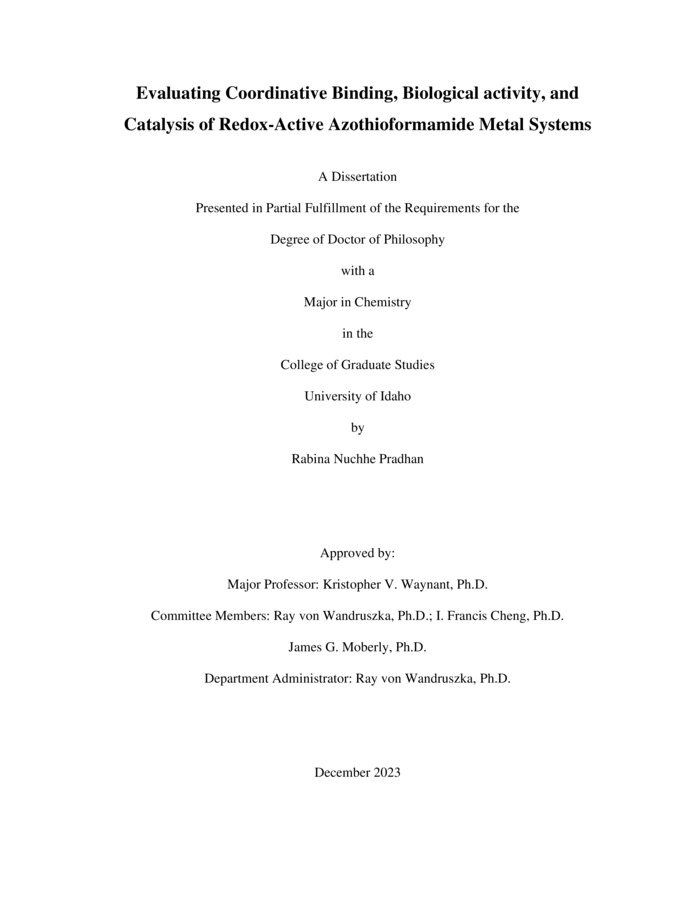Evaluating Coordinative Binding, Biological activity, and Catalysis of Redox-Active Azothioformamide Metal Systems.
Pradhan, Rabina Nuchhe. (2023-12). Evaluating Coordinative Binding, Biological activity, and Catalysis of Redox-Active Azothioformamide Metal Systems.. Theses and Dissertations Collection, University of Idaho Library Digital Collections. https://www.lib.uidaho.edu/digital/etd/items/pradhan_idaho_0089e_12737.html
- Title:
- Evaluating Coordinative Binding, Biological activity, and Catalysis of Redox-Active Azothioformamide Metal Systems.
- Author:
- Pradhan, Rabina Nuchhe
- Date:
- 2023-12
- Program:
- Chemistry
- Subject Category:
- Chemistry
- Abstract:
-
Redox active Azothioformamide (ATF) ligands dissolve and/or coordinate various transition metal and metal salts to form unique ligand:metal coordination complexes. Single crystal X-ray diffraction and UV-Vis titration studies have indicated that ATF ligands form 1:1 μ-X halogen-bridged dimers from copper(I) halides, and 2:1 ligand:metal complexes from Copper(I) salts containing non-coordinative counterions (BF4-, PF6-). When ATFs are appended with electron-donating moieties there is an increased binding association which was confirmed by DFT calculations to show more exergonic interactions while electron-withdrawing moieties provided weaker binding association interactions. Furthermore, the preference of 2:1 non-linear binding model over 1:1 binding model were then studied through the coordination complexes formed by reacting Cu(I) salts with a range of monosubstituted electron-donating ATF ligands. The findings, supported by crystal structures and UV-Vis binding studies, were further substantiated through computational evaluations of potential mechanisms, elucidating the unique 2:1 binding regime. These insights into the binding mechanisms and coordination strengths of substituted ATF ligands pave the way for their application as catalyst for metal-catalyzed reactions and biological applications. Notably it was found that non-complexed ATF compounds have limited activity, while ATF-metal coordination complexes exhibit varying effects against microbes, highlighting their potential in antimicrobial applications. Furthermore, the feasibility of Cu(I)-ATF complexes as a catalyst for the insertion of CO2 into C-H alkyne bonds was also studied and it was found out that Cu(I) complexes, both 2:1 and 2:2 dimers with ATF ligand having electron donating group gave high yield. Overall, through comprehensive exploration of binding affinity and coordination intricacies, the potential of ATF ligands in diverse applications from catalysis to biological activity to metal recycling was studied.
- Description:
- doctoral, Ph.D., Chemistry -- University of Idaho - College of Graduate Studies, 2023-12
- Major Professor:
- Waynant, Kristopher KW
- Committee:
- Wandruszka, Ray; Cheng, Francis; Moberly, James
- Defense Date:
- 2023-12
- Identifier:
- Pradhan_idaho_0089E_12737
- Type:
- Text
- Format Original:
- Format:
- application/pdf
- Rights:
- In Copyright - Educational Use Permitted. For more information, please contact University of Idaho Library Special Collections and Archives Department at libspec@uidaho.edu.
- Standardized Rights:
- http://rightsstatements.org/vocab/InC-EDU/1.0/

